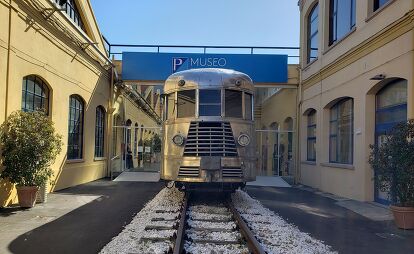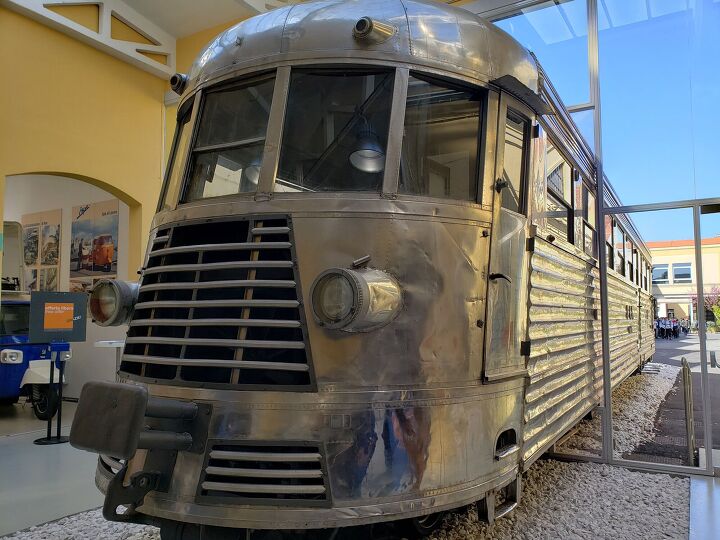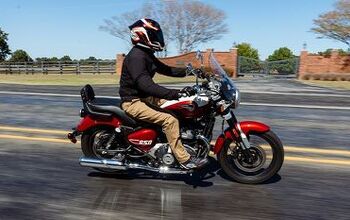Top 10 Sights Seen at the Piaggio Museum in Pontedera

Curated by yours truly
Inside a former tool-shop located on the Piaggio facility’s grounds in Pontedera, Italy sits a treasure trove of history, a time capsule if you will, which allows visitors a look into the past of some, but not all, of the brands currently included under the Piaggio umbrella. The 32,000 sq ft Museum is located in one of the oldest parts of the Piaggio complex where, in the early 1920s after purchasing the facility, Piaggio began production of airplane engines.
Without even entering the museum, the rich history can be felt when walking by the century old buildings. A shining example of Italian industry. Though the history itself is rich and interesting, a top 10 list isn’t the place to try to describe the company’s past 100 years. No, instead we’ll take a look at the top 10 sights seen at the Piaggio Museum in Pontedera as curated by yours truly.
1936 Piaggio MC2 54 Railway
A stainless steel railcar meets you as you approach the museum. In the mid-30s, Piaggio was the first in Italy to start building stainless steel railcars and electric locomotives. Stainless steel was chosen for its lasting qualities and required much less maintenance than other materials and techniques of the time. Piaggio licensed a welding technique from the Philadelphia-based Budd Company known as “shotwelding”. This technology was imperative for joining pieces of stainless steel without damaging its anti-corrosion properties. In 1937, Piaggio sold ten of these MC2 50 series with electric drive to the Ferrovie Calabro-Lucane, a railway of southern Italy. Engine 54 was later purchased back by Piaggio, restored, and parked halfway inside the museum as seen above.
The Paperino
Enrico Piaggio soon realized, at the end of WWII, there would be a market for mass-produced cheap means of transportation which sparked the idea for the MP5. The MP5 or Paperino, the nickname given by the factory workers which meant Donald Duck, was designed by Renzo Spolti, a leading engineer of aircraft production at Piaggio with the help of engineer Vittorio Casini and his team. In 1946, a run of 100 of the MP5s were to be made yet only seven were finished by Piaggio. Enrico was unhappy with the project later and came to Corradino d’Ascanio to have him review and redesign the project. When d’Ascanio later came to Piaggio with the entirely redesigned vehicle Enrico exclaimed, “Sembra una vespa!” (It looks like a wasp!) and the blueprint for the first Vespa was realized.
1950 Vespa Montlhery
Say what you like about the looks of the Vespa pictured above, but it likely holds more world records than you do – 17 to be exact. In an attempt to showcase the sporting side of Vespa, Piaggio set out to claim as many world records as possible at the French circuit for which the model had been named. Over 10 hours of consecutive riding at Autodrome de Linas-Montlhéry, three riders wrapped up the aforementioned world records while covering 1,049 km of racetrack.
Rally Scooters!
Marcello di Brogni piloted this Vespa PX 150 alongside Andrea Revel Nutini on a similarly equipped Vespa through the entirety of the Rally of the Pharaohs taking place in Egypt in 2011. Starting near the pyramids of Giza, the two Vespa team would complete the 3,000 km race thanks to some choice upgrades to their machines and a little help along the way.
1956 Vespa T.A.P.
The French defense ministry commissioned ACMA, Piaggio’s French licensee to build the Vespa T.A.P. (Truppe Aero Portate – air troops carrier) for military use. Six hundred TAPs were made and dropped from aircraft over the years by French troops. Weighing near 254 pounds, these rolling arsenals could reach 40-plus mph with a range of 123 miles. However, the TAP’s 75mm cannons were never meant to be fired from the scooter, rather the gun needed to be removed from the scooter to be used. Bummer. With the seat perched on top of the mounted cannon, that’s what I’d call a weapon of ass destruction.
EkoVespa Project
That there is a 2012 Vespa body covered in fish flesh finished with a resin coating to maintain freshness. To quote the Vespa Museum: “Ekovespa Project by Gianni Depaoli represents the imaginary journey of a Vespa Piaggio in the world. The fish skin that covers it, identifies the multi-ethnicity of the legendary brand. This work of art is part of the Organic Trash Art project, which values the organic waste, using it to create works that touch on themes of eco-sustainability, biodiversity.” ART!
1963 Pentarò
In 1947 the Ape was introduced. The Ape, which translates to Bee in Italian, was meant to be a low cost, easy to drive, low maintenance platform which could be easily transformed for all sorts of use. Whether hauling goats, goods, or hunky Italian Vigili del Fuoco, the Ape was meant to be the working man’s vehicle. This 1963 Pentarò (a five-wheeled Ape) was actually in use until 2002 in the Lucca factory of the Cucirini Cantoni Coats company and lent to the local firemen’s squad.
1980s Piaggio Bravo
The Piaggio Bravos and Super Bravos of the 70s and 80s were particularly captivating. Perhaps because of the number displayed and in chronological order, it was fun to see the styles changes from the 1970s models on the left, to the later 1980s models on the right. Mopeds!
Gilera Rally Racers
On the left we have a Gilera 600 RC which was used in the 1990 Rally of the Pharaohs and the 750 RC on the right which between ‘91-’92 took place in the Rally of Tunisia and Dakar and won the Rally of the Pharaohs in 1992. These are the desert tackling rally raid machines of a different time. In the mid-nineties the trend for these bikes began to wane and with decreased sales, many manufacturers stopped racing rallies. These bikes are an interesting window into the Adventure scene of thirty years ago, though these machines were actually being raced with regularity.
Aprilia RS 125 – Valentino Rossi
Although I tried to keep this list weird and eccentric, the amount of racing history in the Piaggio museum should also not be understated. Rossi’s second season racing the world championship resulted in 11 out of 15 races wins on board this 125 and would set the stage for the magnificent racing career the Italian champion continues to write to this day.

Ryan’s time in the motorcycle industry has revolved around sales and marketing prior to landing a gig at Motorcycle.com. An avid motorcyclist, interested in all shapes, sizes, and colors of motorized two-wheeled vehicles, Ryan brings a young, passionate enthusiasm to the digital pages of MO.
More by Ryan Adams

















































Comments
Join the conversation
Beautiful!
Imagine the shame of a Soviet tank commander having his T-62 taken out by a scooter.